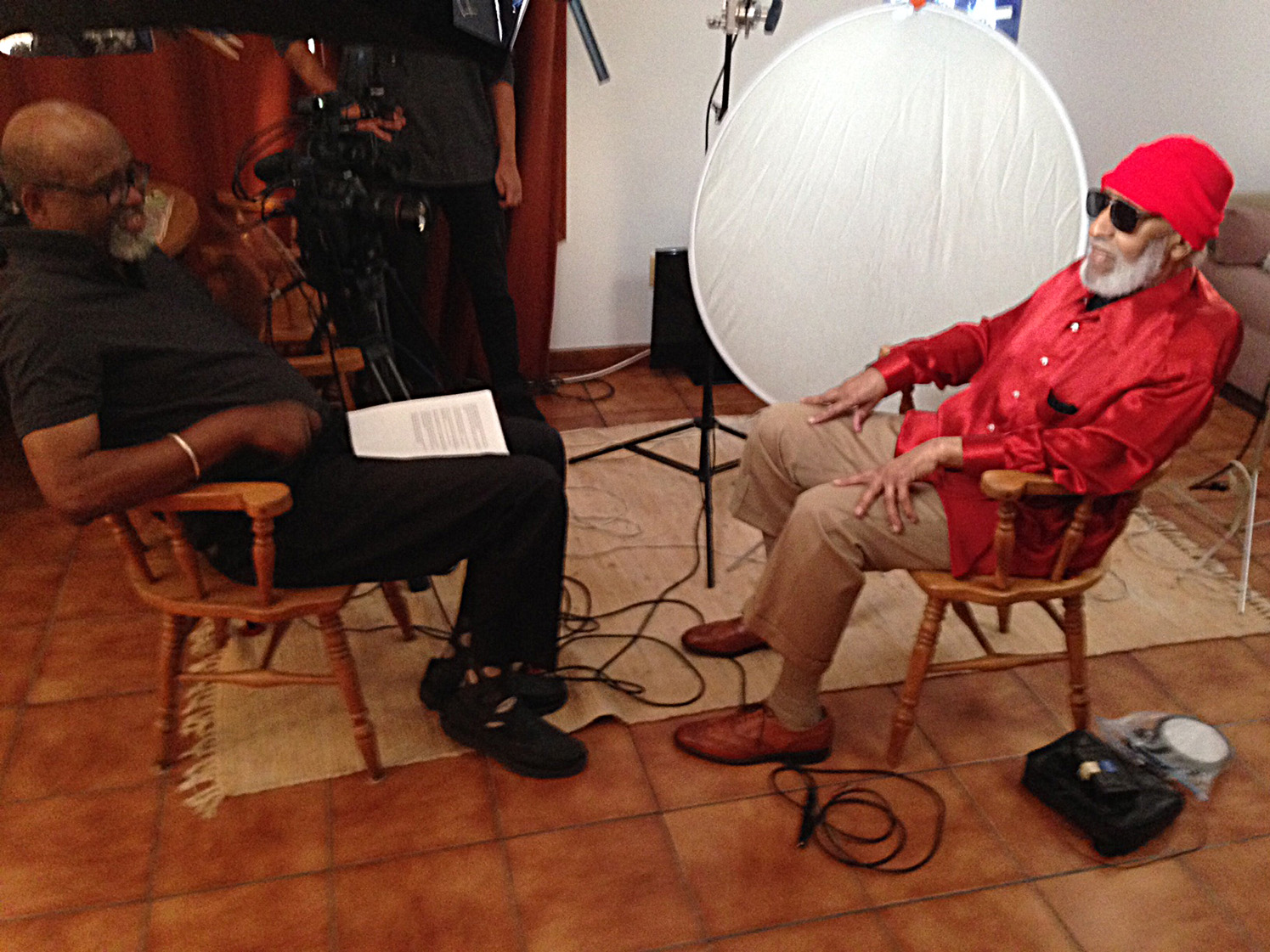
23 May The Drum Also Waltzes: An Interview with Directors Sam Pollard and Ben Shapiro
BY JOHN MORRISON
To understand the nature of jazz as an expression of both the cultural wealth and political aspirations of Black America, one need not look further than the life and career of the drummer Max Roach. A relentless experimenter, in his early days, Roach was a part of the small cadre of musicians who ushered in the bebop revolution. Playing alongside giants like Charlie Parker, Coleman Hawkins, Dizzy Gillespie, Miles Davis, Thelonious Monk, and Bud Powell, Roach and his collaborators were responsible for completely reshaping the harmonic, melodic, and rhythmic character of jazz.
The 2023 film Max Roach: The Drum Also Waltzes is a beautiful documentary that captures the strife, triumph, and boundless creativity that pervaded Roach’s life. Following the tragic death of his musical partner, the trumpeter Clifford Brown, in 1956, Roach continued to produce challenging, ever-evolving music, and in 1961 he released the landmark album We Insist! Max Roach’s Freedom Now Suite. With vocals from his then wife, Abbey Lincoln, We Insist! captured the complex mixture of optimism and rage that characterized the mood of Black America during the Civil Rights movement. The film combines rich archival footage with unique interviews from the jazz legend’s friends to tell Roach’s story. As the director of powerful documentaries like 2018’s Mr. Soul!, MLK/FBI, and Lowndes County and the Road to Black Power, Sam Pollard has built an impressive body of work depicting the nuances of Black political, social, and cultural life. Ben Shapiro is a celebrated Emmy and Peabody award-winning director, producer, and cinematographer whose work spans radio, film, and television. Pollard and Shapiro combine their gifts for storytelling in The Drum Also Waltzes, documenting both the dynamic political landscape and fearless approach to creativity that defined Max Roach’s career. cinéSPEAK spoke with directors Sam Pollard and Ben Shapiro about jazz, Max Roach, and the decades-long process of bringing this story to life.
This interview was edited for length and clarity.

cinéSPEAK: So, y’all were both separately documenting Max Roach’s life and work. Could you tell me a little bit about how y’all became aware of one another and what made y’all ultimately decide to collaborate on this film together?
Ben Shapiro: Yeah, we both had been working on different projects involving Max Roach and interviewing him. Sam had shot this footage and I’d done these audio interviews and sometime later Sam and I worked on a project together and got to be friends. And then we decided it was time to try to combine [our material] and do new interviews and essentially finish the film that he had started to make in the 1980s.
Sam Pollard: I was introduced to Max by the late [filmmaker] St. Clair Bourne in 1983. I was working on a documentary about Langston Hughes [that] St. Clair directed. He did a segment where Max played the drum solo to a Langston Hughes poem. And I remember editing that footage and really getting very excited about it. I turned to St. one day and I said, “You know, someone should make a film about Mr. Roach.” And he said, “You should.” And I was sort of knocked off my feet because I had never directed anything. And I said, “Really?” But he introduced me to Max. I went to see Max perform at [famed New York nightclub] S.O.B.s. Max was performing with M’Boom, his percussion ensemble. We went to see him play, and St. took me down to the dressing room at the end of the set and introduced me to Max.
I pitched the idea of doing a doc about Max and [he] seemed to be cool with it. [My producer and I] applied for a grant from the New York State Council of the Arts in around 1987 [or] ‘88. We shot an interview at his house, and then we shot a rehearsal session with M’Boom. Then we had enough money left to go to San Diego to shoot Max when he was working on a score for a contemporary version of A Midsummer Night’s Dream, [and we were able] to fly to Milan [where] Max was doing a woodwind string concert where he was the major feature. We went and shot that in ‘87 or ‘88. And then it took years for me to meet Ben Shapiro, who basically said, “Man, you gotta make this thing happen.”

cinéSPEAK: What was it about Max that made both of you think, “Yo, this is somebody whose story needs to be documented?” What was it about him and his work?
SP: What I love about Max Roach was that he was not a musician who sat on his laurels. He constantly evolved. Here was a guy who grew up in Bed-Stuy, ended up playing with Charlie Parker, Coleman Hawkins, Dizzy Gillespie, Thelonious Monk, and [was] part of that whole notion of what was modern [then] jazz/bebop. But then in the ‘50s, he created his own group which he co-led with Mr. Brown and Sonny Rollins and Harold Land and Richie Powell. And then, he got politically active and he created We Insist! The Freedom Now Suite. Here was a guy who decided that the drums didn’t [just] have to be an instrument for timekeeping. He became a soloist and you get to have solo drum concerts. He just evolved. I saw him as a Renaissance man, and he was a hero to me.
cinéSPEAK: There’s a line in the film when Harry Belafonte describes bebop as an outraged expression, but he also says that bebop found great synergy amongst young Black folks in the 1940s. Could y’all talk a little bit about that relationship between modern jazz and the political aspirations of Black folks at the time? Were they related? And if so, how?
SP: Well, [in terms of popularity], jazz was at its zenith in the ‘30s into the mid ‘40s. It was popular music, plus in that period it was really dance music. But all of a sudden, these young iconoclasts come along, Mr. Monk, Bud Powell, Charlie Parker, Dizzy Gillespie, Kenny Clarke, Max Roach, and they’re basically saying, we wanna create a different kind of music that’s gonna be harmonically more challenging and rhythmically more challenging. And it wasn’t about so much pandering to the audience. It was about all of them listening to each other [and] saying, we gonna go to another level musically. By the mid ‘50s to the early ‘60s, some of them evolved both from a musical perspective, but also from a political perspective. Max Roach probably being one of the leading [people] from that whole bebop generation who led to other musicians becoming much more engaged from a social and political perspective.

cinéSPEAK: I’m curious about the Freedom Now Suite. Why was it so significant and what impact did that album have on Max’s career?
BS: It’s clearly a landmark in several respects. If you just look at it musically, it’s very adventurous and formally bold. This idea of doing this song cycle essentially around these grand historical themes but from a very clear, pointed political perspective was extremely innovative at that time. I think it did break things free in a lot of ways. In terms of their careers, Max in the film says that around that time he said he wasn’t gonna do any music that wasn’t political. And obviously that had ramifications in terms of the music business, which he felt pretty quickly. In clubs, he would get up and talk about the music from a political perspective. And I think clubs wanted him to stop doing that–some of them started offering him fewer gigs. The record companies were kind of less interested in that. So I think it had implications in terms of [his] career. But he was so committed he didn’t really ever back down from that.
cinéSPEAK: The film opens with a wonderful quote from Max where he says that music can be used “as a weapon against man’s inhumanity toward man.” Could you talk a little bit about what legacy Max left behind, politically and musically? What can we learn from his life and from this film?
BS: That there are no boundaries and that you can freely experiment in any direction. The possibilities are open to be explored and every step along the way, he was breaking boundaries. That’s what his career and life was about, to a large extent.
*Featured Image: Behind-the-scenes image of Sam Pollard interviewing Sonny Rollins. Courtesy of the filmmakers.

John Morrison is a writer, DJ, and radio host from Philadelphia. His work has appeared in NPR Music, Red Bull Music Academy, Bandcamp Daily, and more. He is also a member of the cinéSPEAK Journal Editorial Collective.

Sorry, the comment form is closed at this time.